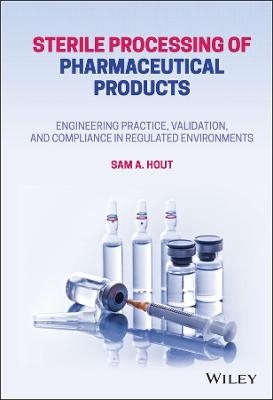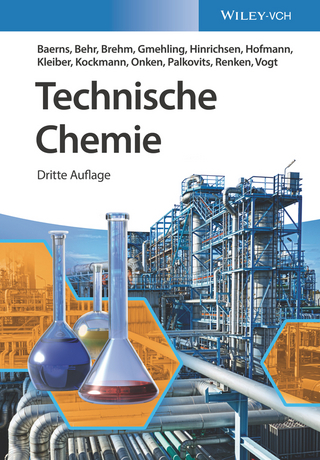
Sterile Processing of Pharmaceutical Products
John Wiley & Sons Inc (Verlag)
978-1-119-80232-7 (ISBN)
Thoroughly trained personnel and carefully designed, operated, and maintained facilities and equipment are vital for the sterile manufacture of medicinal products using aseptic processing. Professionals in pharmaceutical and biopharmaceutical manufacturing facilities must have a clear understanding of current good manufacturing practice (cGMP) and preapproval inspection (PAI) requirements.
Sterile Processing of Pharmaceutical Products: Engineering Practice, Validation, and Compliance in Regulated Environments provides up-to-date coverage of aseptic processing techniques and sterilization methods. Written by a recognized expert with more than 20 years of industry experience in aseptic manufacturing, this practical resource illustrates a comprehensive approach to sterile manufacturing engineering that can achieve drug manufacturing objectives and goals. Topics include sanitary piping and equipment, cleaning and manufacturing process validation, computerized automated systems, personal protective equipment (PPE), clean-in-place (CIP) systems, barriers and isolators, and guidelines for statistical procedure. Offering authoritative guidance on the key aspects of sterile manufacturing engineering, this volume:
Covers fundamentals of aseptic techniques, quality by design, risk assessment and management, and operational requirements
Addresses various regulations and guidelines instituted by the FDA, ISPE, EMA, MHRA, and ICH
Provides techniques for systematic process optimization and good manufacturing practice
Emphasizes the importance of attention to detail in process development and validation
Features real-world examples highlighting different aspects of drug manufacturing
Sterile Processing of Pharmaceutical Products: Engineering Practice, Validation, and Compliance in Regulated Environments is an indispensable reference and guide for all chemists, chemical engineers, pharmaceutical professionals and engineers, and other professionals working in pharmaceutical sciences and manufacturing.
Sam A. Hout, PhD, MBA, is a Chartered Chemical Engineer, certified in business management by the American Production and Inventory Control Society (APICS), and a member of the International Society of Pharmaceutical Engineers (ISPE). Dr. Hout held the position of Senior Director of Engineering, project management, and technology process transfers at Siegfried Pharmaceuticals. Previously, he was Senior Manager of Engineering at TEVA Pharmaceuticals and Director of Operations at the HPLC company Phenomenex.
Preface xiii
Acknowledgments xvii
1 Introduction 1
2 Sterilization 4
Steam Sterilization 5
Flash Sterilization 5
Low-Temperature Sterilization Technologies 6
Ethylene Oxide Gas Sterilization 6
Hydrogen Peroxide Gas Plasma 7
Disinfection and Surface Sterilization Using Peracetic Acid 7
Ionizing Radiation 8
Dry-Heat Sterilizers 8
Filtration 9
Microwave 9
Vaporized Hydrogen Peroxide (VHP®) 9
Ozone 9
Formaldehyde Steam 10
Gaseous Chlorine Dioxide 10
Vaporized Peracetic Acid 10
Infrared Radiation 10
Sterilization Cycle Verification 11
Monitoring 11
3 Sterile Manufacturing Facilities 15
4 Sanitary Process Piping and Equipment 17
QA Procedures 18
Standard Operating Procedures – cGMP Installations 19
Heat Exchangers 19
Sanitary Pumps 20
Sanitary Tanks 20
Instruments 21
Pressure Transmitter (Various Sources) 21
Temperature Transmitter (Various Sources) 21
Standard Operating Procedures – cGMP Installations 25
Surface Finish 30
Welding 32
Applicability 33
Process/Procedure 39
Records (General) 41
Records 44
Automatic Orbital Welding 47
Weld Acceptance Criteria for Automatic Orbital Weld Qualifications 47
5 Passivation 49
In-house Passivation Using Vats 51
Spot Passivation 53
Astro Pak UltraPass Gel Passivation 53
Alternative Process 54
Control of Passivated Items 57
Preparing, Testing, and Adjusting Cleaning and Passivation Chemicals (Passivation in Vats) 58
6 Chilled Water System 63
Process Description 65
Commissioning of HVAC 75
Installation Verification – X Ton Chiller System 78
SystemStartup – X Ton Chiller 81
Functional Testing – X Ton Chiller 82
7 Clean-In-Place (CIP) Systems 84
Life Cycle Requirements 86
Product and Process User Requirements 86
Process Quality Requirements 86
Process Parameter Requirements 87
Installation User Requirements 87
Operational Requirements 91
8 Computerized Automated Systems 95
Functional Requirement Specification 95
Process Automation System 95
EMS User Requirement Specification 96
Automation Overview 96
Software 97
Hardware 97
SCADA 97
Control Panels 97
Main Control Panel 97
Remote I/O Panels 98
Power Distribution Panels 98
Instrumentation Panels 98
System Functions 98
System Overview 98
Control Modules 99
Interfaces 99
User Interface (SCADA) 99
PAS System Overview 99
Graphical Screen Navigation 99
Client EMS Area Graphical Screens 99
Graphical Control Screens 99
Interfaces to Equipment 101
Interfaces to Other Systems 101
Ethernet Network 101
Nonfunctional Attributes 101
Power Failure Recovery 101
PLC Only Failure 101
HMI Only Failure 101
Network Only Failure 101
Maintainability 102
Backup and Recovery 102
Functional Requirement Specification 102
GLC Environmental Monitoring System 102
Automation Overview 103
System Components 104
Software 104
Hardware 104
Control Panels 104
Gateways 105
System Functions 105
System Overview 105
Control Modules 105
Interfaces 105
User Interface (SCADA) 105
GLC EMS Area Graphical Screen 105
Global Logistics Center (GLC) Environmental Monitoring System 105
Interfaces to Equipment 105
Interfaces to Other Systems 106
Ethernet Network 106
Wireless Connections 106
Nonfunctional Attributes 106
Power Failure Recovery 106
PLC Only Failure 106
HMI Only Failure 106
Network Only Failure 106
Maintainability 107
Backup and Recovery 107
Software Module Design Specification 107
Functional Requirement Specification 108
Process Automation System 108
Automation Overview 109
System Components 109
Software 109
Hardware 110
Control Panels 110
System Functions 111
System Overview 111
Control Modules 111
Interfaces 111
User Interface (SCADA) 111
PAS System Overview Screen 112
Graphical Screen Navigation 112
Graphical Control Screens 112
Interfaces to Equipment 113
Interfaces to Other Systems 113
Ethernet Network 113
Nonfunctional Attributes 114
Power Failure Recovery 114
PLC Only Failure 114
HMI Only Failure 114
Network Only Failure 114
Maintainability 114
Backup and Recovery 114
Software Design Specification 115
Prosoft Configuration 115
Enabling and Disabling of the Gateway Default Server Interface 115
Temperature Sensor Settings 116
Humidity Sensor Settings 116
Software Design Specification 116
Continuous Logic 116
Module Classes and Control Modules 116
Virtual Differential Pressure Alarm Disable 116
Room Condition Indication 117
Navigation Links 117
Alarm Daily Report 118
WFI Still Equipment Module Class 118
WFI Silo Equipment Module Class 126
EM_SILO 126
WFI Primary Loop Equipment Module Class 143
EM_PRIM_LOOP 143
WFI Supply Header Equipment Module Class 155
EM_HEADER 155
Electrical – Controls Equipment Specifications 162
Documentation 165
Drives/Motors 165
9 Personal Protective Equipment (PPE) and Process Flow 170
10 Sterile Aseptic Processing 172
11 Integrated Facility Design 174
Case Study 178
Issue 178
Root Cause 178
Corrective Action 179
Preventive Actions 179
12 Barriers and Isolators 180
Isolator Design Considerations 181
13 Guidelines for Statistical Procedure 183
Process Capability Analysis 184
Long-term Studies 186
Acceptance Sampling 187
Attribute and Variable Sampling Plans 187
Variable Sampling Plans – ANSI Z1.9 188
Normality 188
Transformation of Non-normal Data (Normalization) 190
Protocol Sampling 190
Failure Mode and Effect Analysis (FMEA) 191
Calculating or Recalculating Control Limits 193
14 Calibration 194
Contingency Plan/Disaster Recovery 204
15 Cleaning Validation 205
New Products and Product Changes 208
Cleaning Processes and Changes 208
Risk Assessment/Matrix Approach 209
Matrix Development 209
Cleaning Processes (Manual and Automated) 210
CPP/CQA 210
Cleaning Validation Life Cycle – Cleaning Method Development 211
Strategy for Process Controls 211
Worst-Case Identification – Product/Component 211
Equipment 212
Validation Tests/Inspections – Visual Inspection 212
Chemical Testing 212
Microbiological Testing 213
Endotoxin Testing 213
Sampling Methods 213
Direct Swab Sampling 214
Rinse Sampling 214
Coupon Testing 214
Sampling Sites 214
Acceptance Criteria 214
Residual Levels 214
Endotoxin Levels 215
Microbiological Levels 215
Cleaning Agents/Sanitizer Validation Studies 215
Hold Time Development 216
Dirty Hold Time 216
Clean Hold Time 217
Additional Hold Times/Cleaning Frequencies 217
Continuous Process Verification 217
Failure Investigations 217
16 Validation of Filling Equipment 218
Technical References 223
17 Manufacturing Process Validation 224
Stage 2 – Process Qualification 229
Appendix A Installation Test Plans 232
Appendix B Operational Tests Plans 235
Appendix C WFI Turbulence Flow Requirements 238
Appendix D Water For Injection (WFI) – Design Requirements 239
Process Description 240
Specifications 241
Life Cycle Requirements 241
Product and Process User Requirements 241
Product Description 241
Operating Ranges 243
Material of Construction 244
Metallics 244
Plastics 244
Elastomers 244
Glass 244
Welding Requirements 245
Construction Requirements 246
Lubrication Requirements 247
Electrical Requirements 247
Safety Requirements 247
Operational Requirements 248
Process Constraints and Limitations 248
Process Control System 248
Operator Interface 249
Power Loss and Recovery 250
Cleaning and Sanitizing 250
Maintenance Requirements 250
Training and Documentation Requirements 250
Appendix E Solution Transfer System (STS) – Design Requirements 252
System Description 253
Bulk Powder Handling System 255
Glossary 259
Nomenclature 261
References 263
Further Reading 267
Index 335
| Erscheinungsdatum | 25.01.2022 |
|---|---|
| Verlagsort | New York |
| Sprache | englisch |
| Maße | 10 x 10 mm |
| Gewicht | 454 g |
| Themenwelt | Naturwissenschaften ► Chemie ► Technische Chemie |
| Technik | |
| ISBN-10 | 1-119-80232-6 / 1119802326 |
| ISBN-13 | 978-1-119-80232-7 / 9781119802327 |
| Zustand | Neuware |
| Informationen gemäß Produktsicherheitsverordnung (GPSR) | |
| Haben Sie eine Frage zum Produkt? |
aus dem Bereich


